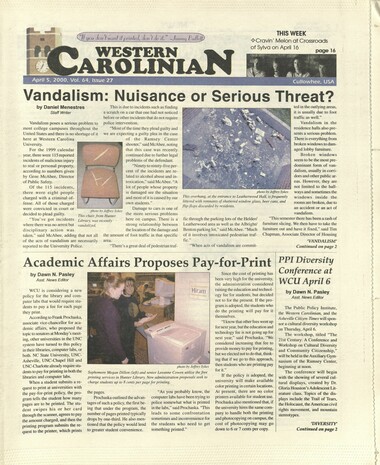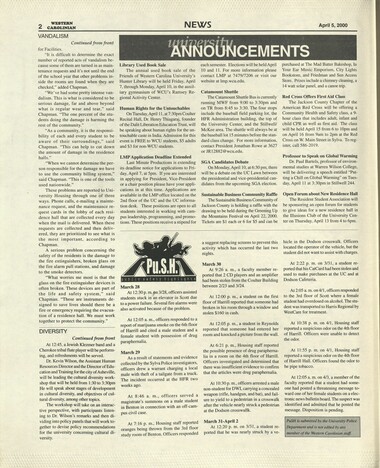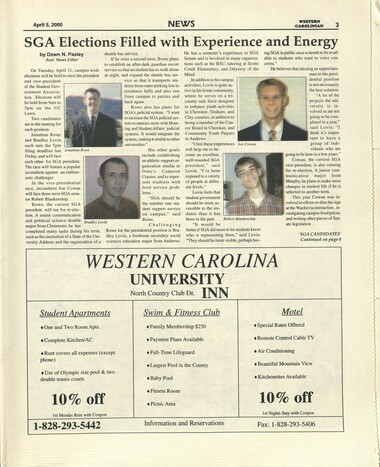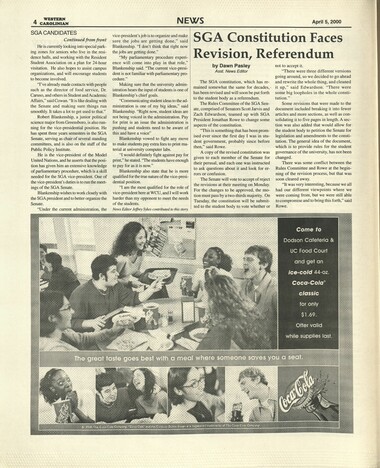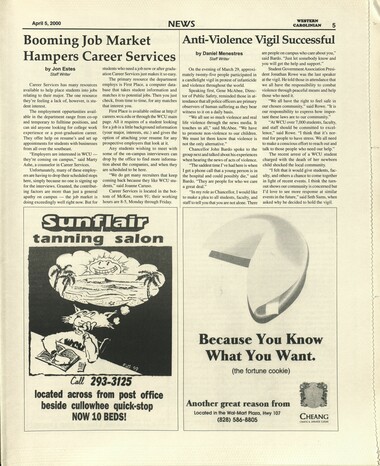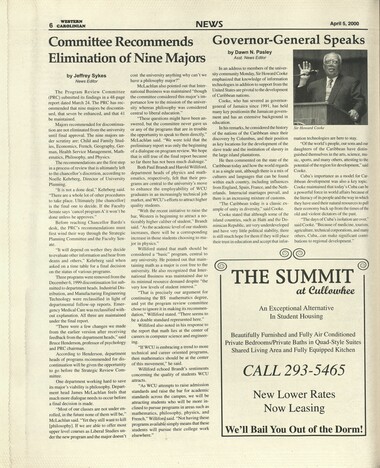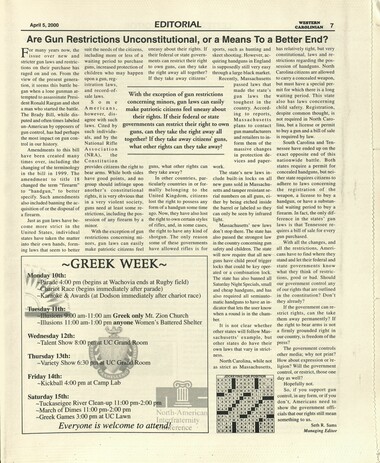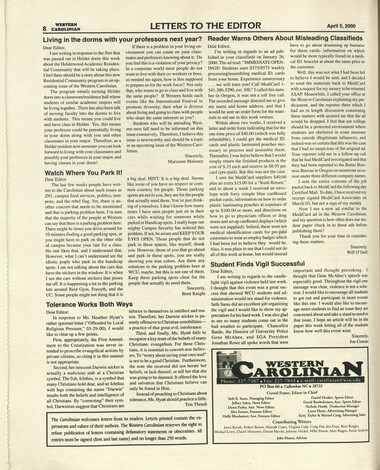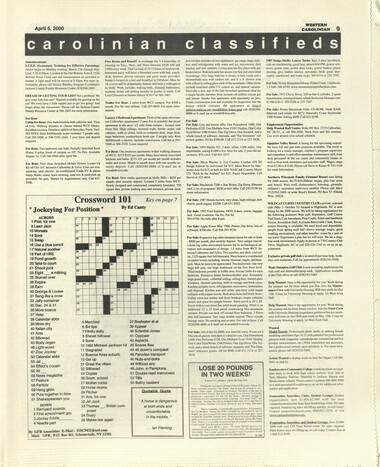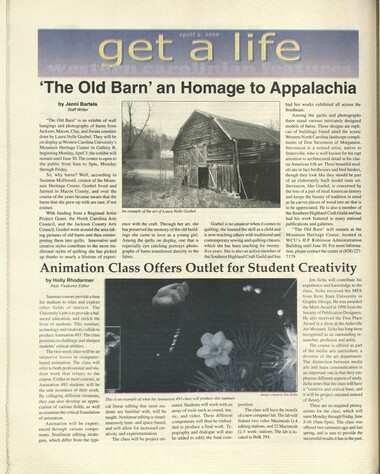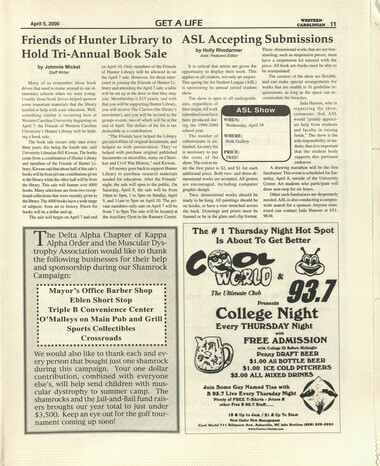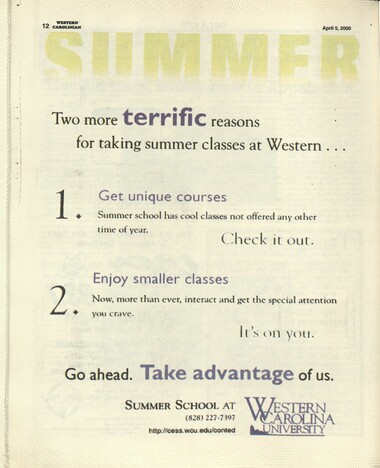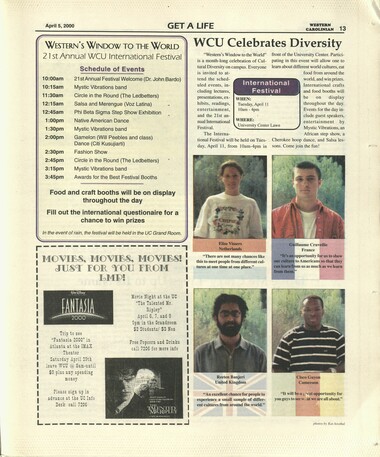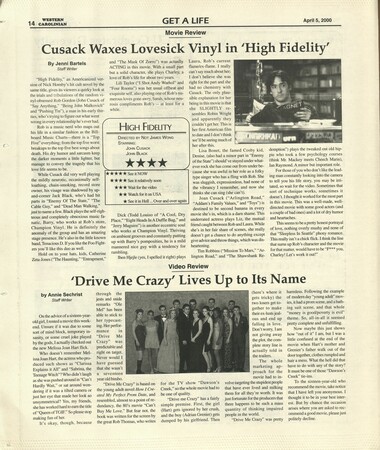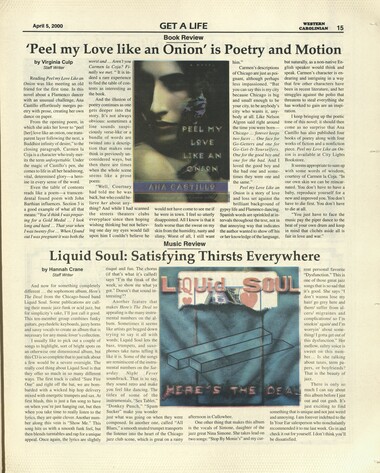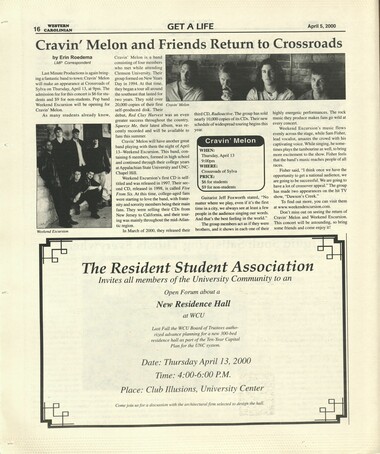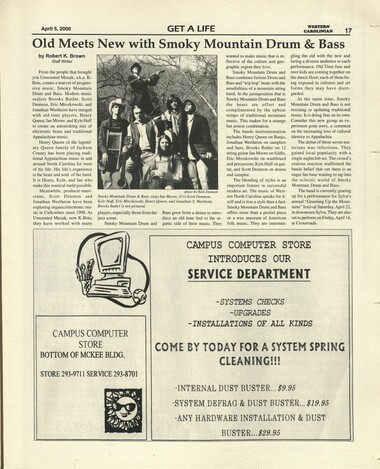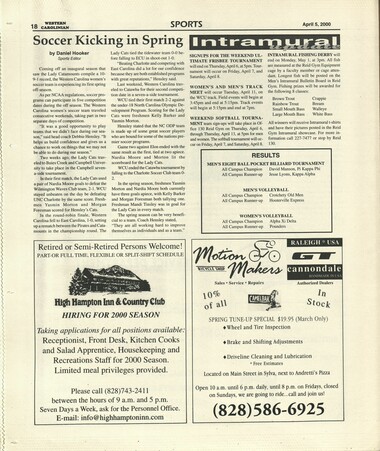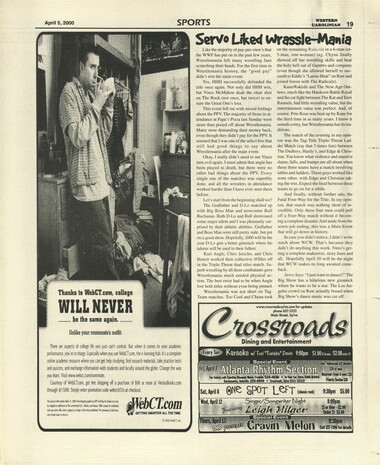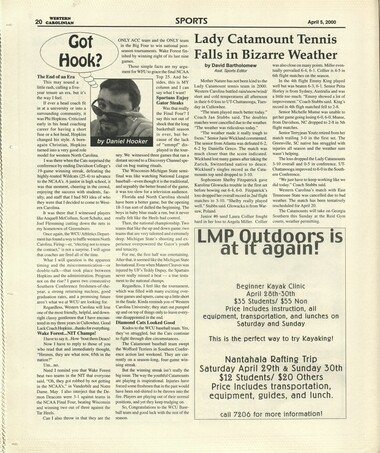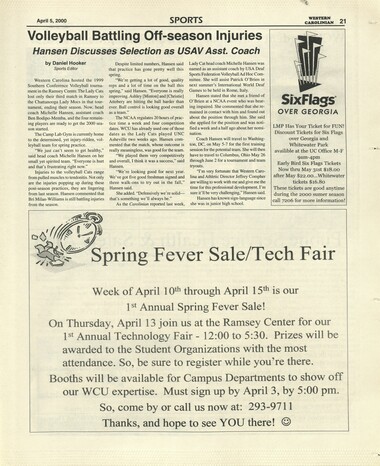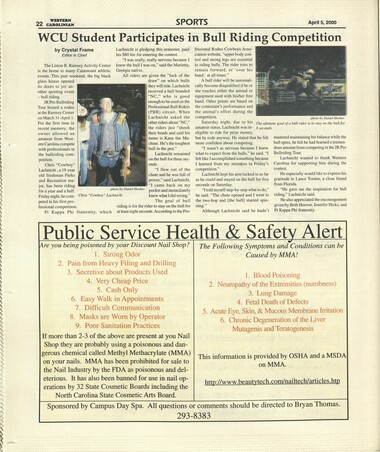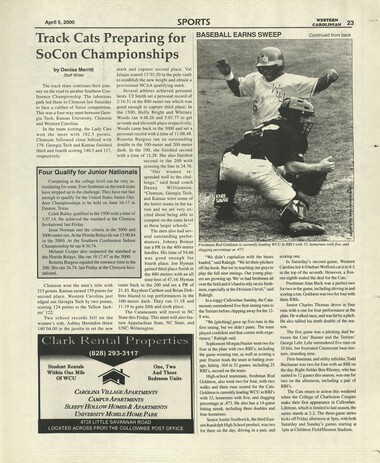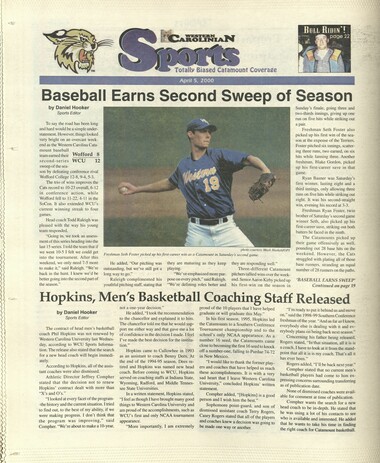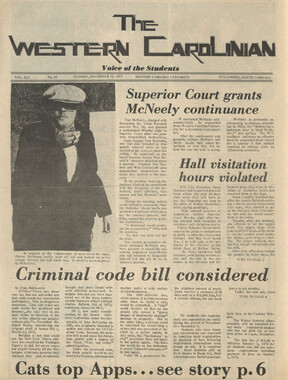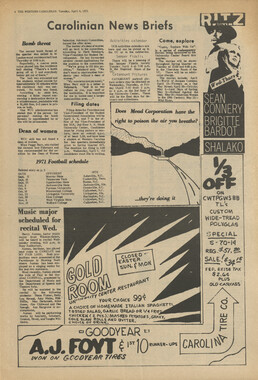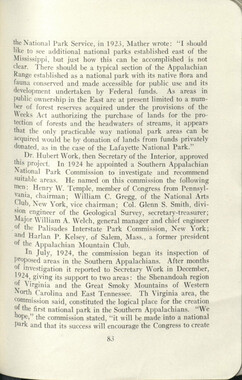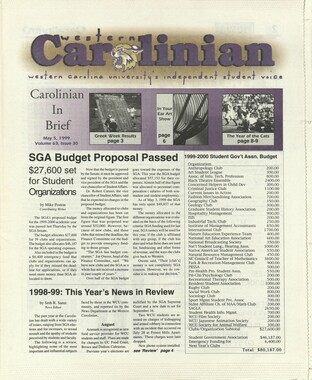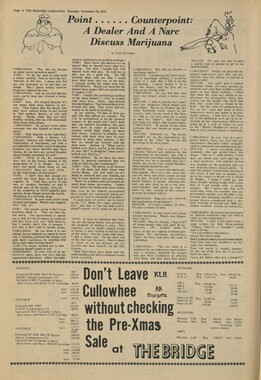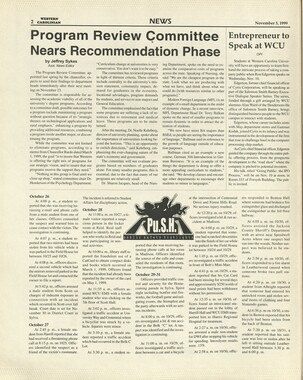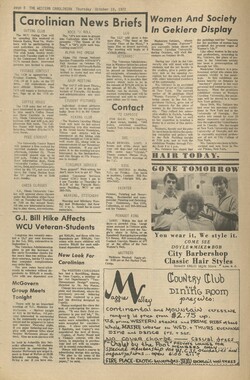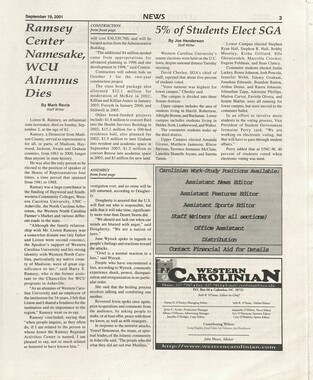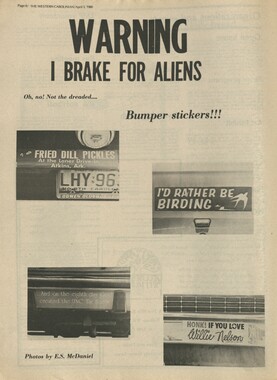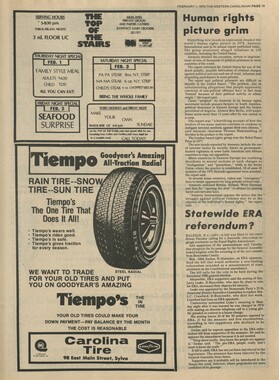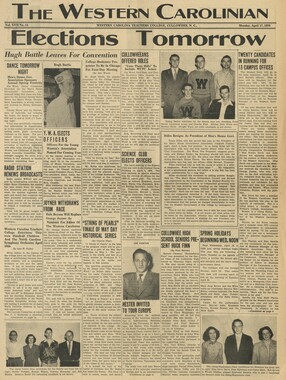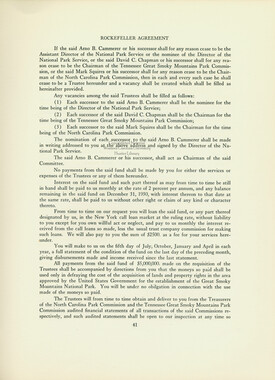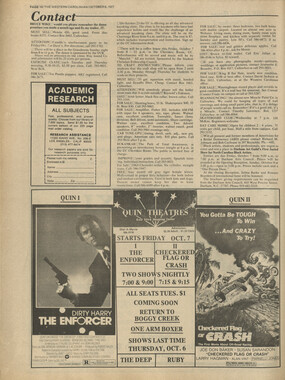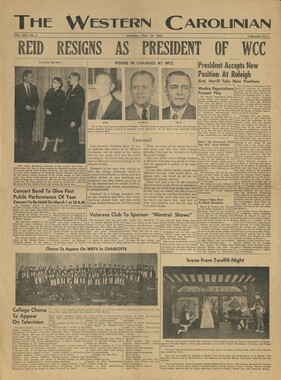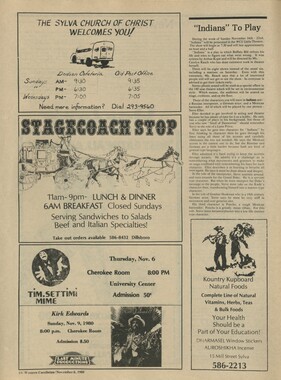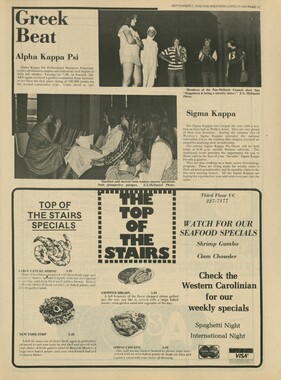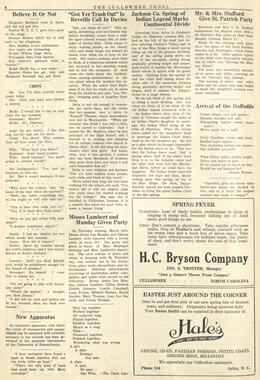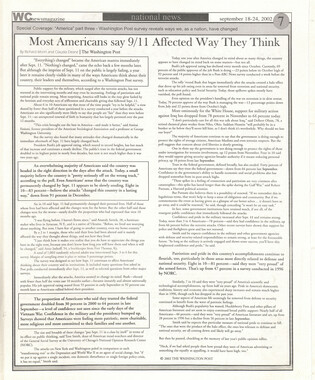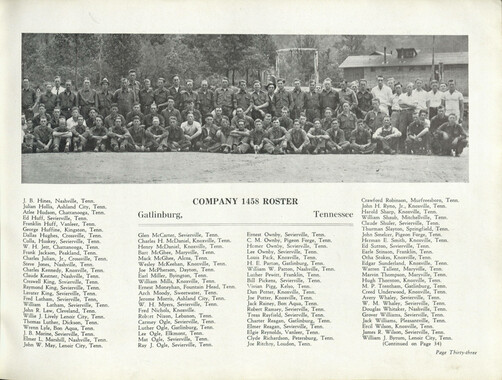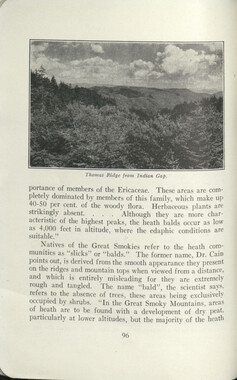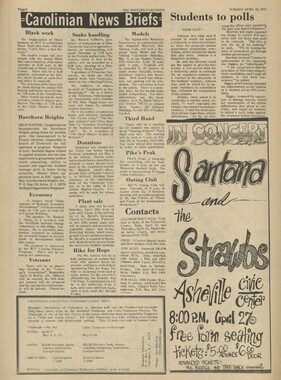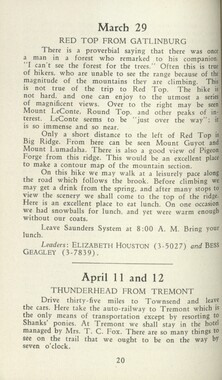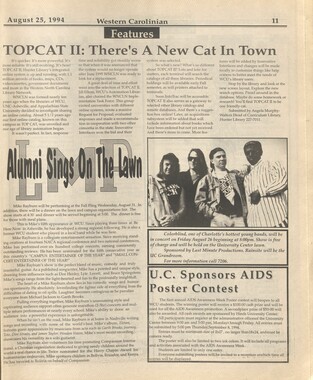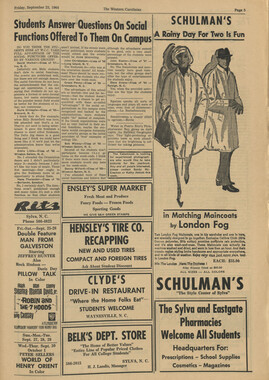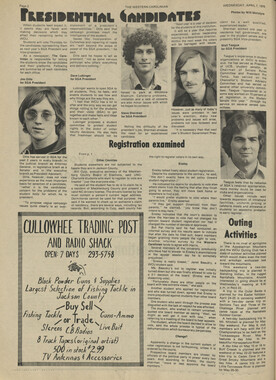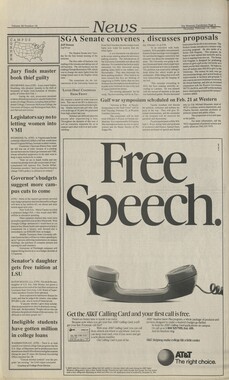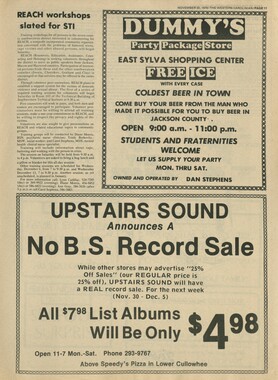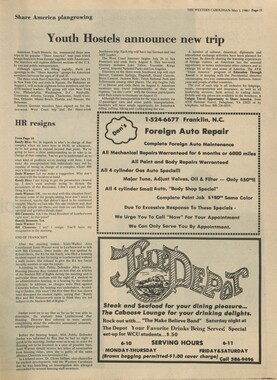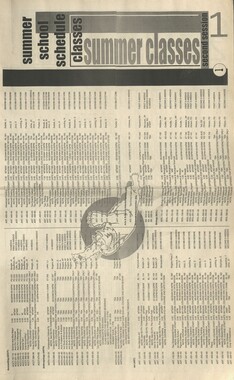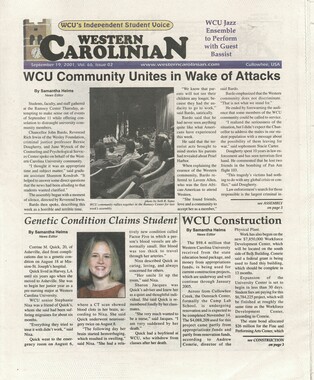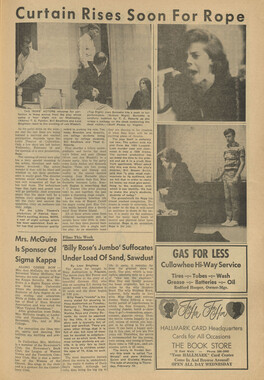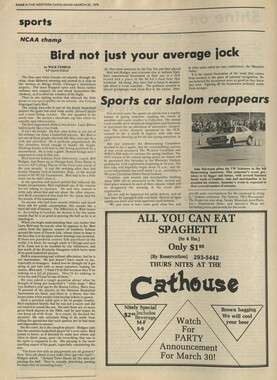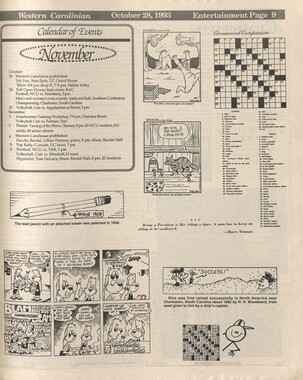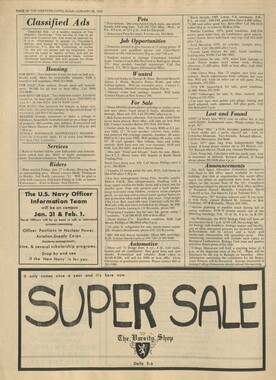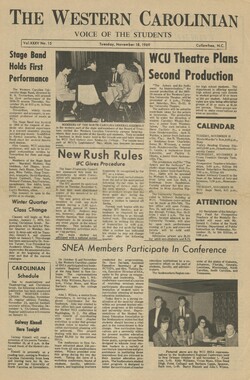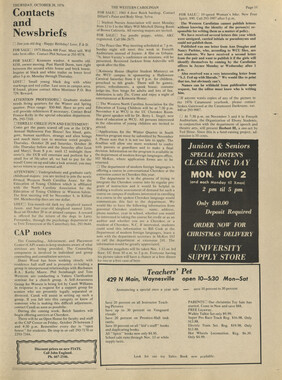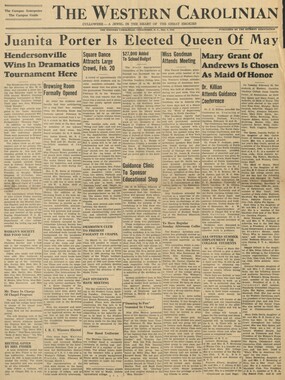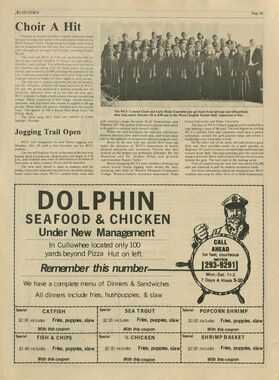Western Carolina University (20)
View all
- Canton Champion Fibre Company (2308)
- Cherokee Traditions (292)
- Civil War in Southern Appalachia (165)
- Craft Revival (1942)
- Great Smoky Mountains - A Park for America (2766)
- Highlights from Western Carolina University (430)
- Horace Kephart (941)
- Journeys Through Jackson (154)
- LGBTQIA+ Archive of Jackson County (85)
- Oral Histories of Western North Carolina (314)
- Picturing Appalachia (6772)
- Stories of Mountain Folk (413)
- Travel Western North Carolina (160)
- Western Carolina University Fine Art Museum Vitreograph Collection (129)
- Western Carolina University Herbarium (92)
- Western Carolina University: Making Memories (708)
- Western Carolina University Publications (2283)
- Western Carolina University Restricted Electronic Theses and Dissertations (146)
- Western North Carolina Regional Maps (71)
- World War II in Southern Appalachia (131)
University of North Carolina Asheville (6)
View all
- Allanstand Cottage Industries (62)
- Appalachian National Park Association (53)
- Bennett, Kelly, 1890-1974 (1388)
- Berry, Walter (76)
- Brasstown Carvers (40)
- Carver, George Washington, 1864?-1943 (26)
- Cathey, Joseph, 1803-1874 (1)
- Champion Fibre Company (233)
- Champion Paper and Fibre Company (297)
- Cherokee Indian Fair Association (16)
- Cherokee Language Program (22)
- Crowe, Amanda (40)
- Edmonston, Thomas Benton, 1842-1907 (7)
- Ensley, A. L. (Abraham Lincoln), 1865-1948 (275)
- Fromer, Irving Rhodes, 1913-1994 (70)
- George Butz (BFS 1907) (46)
- Goodrich, Frances Louisa (120)
- Grant, George Alexander, 1891-1964 (96)
- Heard, Marian Gladys (60)
- Kephart, Calvin, 1883-1969 (15)
- Kephart, Horace, 1862-1931 (313)
- Kephart, Laura, 1862-1954 (39)
- Laney, Gideon Thomas, 1889-1976 (439)
- Masa, George, 1881-1933 (61)
- McElhinney, William Julian, 1896-1953 (44)
- Niggli, Josephina, 1910-1983 (10)
- North Carolina Park Commission (105)
- Osborne, Kezia Stradley (9)
- Owens, Samuel Robert, 1918-1995 (11)
- Penland Weavers and Potters (36)
- Roberts, Vivienne (15)
- Roth, Albert, 1890-1974 (142)
- Schenck, Carl Alwin, 1868-1955 (1)
- Sherrill's Photography Studio (2565)
- Southern Highland Handicraft Guild (127)
- Southern Highlanders, Inc. (71)
- Stalcup, Jesse Bryson (46)
- Stearns, I. K. (213)
- Thompson, James Edward, 1880-1976 (226)
- United States. Indian Arts and Crafts Board (130)
- USFS (683)
- Vance, Zebulon Baird, 1830-1894 (1)
- Weaver, Zebulon, 1872-1948 (58)
- Western Carolina College (230)
- Western Carolina Teachers College (282)
- Western Carolina University (1794)
- Western Carolina University. Mountain Heritage Center (18)
- Whitman, Walt, 1819-1892 (10)
- Wilburn, Hiram Coleman, 1880-1967 (73)
- Williams, Isadora (3)
- Cain, Doreyl Ammons (0)
- Crittenden, Lorraine (0)
- Rhodes, Judy (0)
- Smith, Edward Clark (0)
- Appalachian Region, Southern (2569)
- Asheville (N.C.) (1923)
- Avery County (N.C.) (26)
- Blount County (Tenn.) (161)
- Buncombe County (N.C.) (1672)
- Cherokee County (N.C.) (283)
- Clay County (N.C.) (555)
- Graham County (N.C.) (233)
- Great Smoky Mountains National Park (N.C. and Tenn.) (519)
- Haywood County (N.C.) (3524)
- Henderson County (N.C.) (70)
- Jackson County (N.C.) (4694)
- Knox County (Tenn.) (25)
- Knoxville (Tenn.) (12)
- Lake Santeetlah (N.C.) (10)
- Macon County (N.C.) (420)
- Madison County (N.C.) (212)
- McDowell County (N.C.) (39)
- Mitchell County (N.C.) (132)
- Polk County (N.C.) (35)
- Qualla Boundary (981)
- Rutherford County (N.C.) (76)
- Swain County (N.C.) (2115)
- Transylvania County (N.C.) (270)
- Watauga County (N.C.) (12)
- Waynesville (N.C.) (84)
- Yancey County (N.C.) (72)
- Aerial Photographs (3)
- Aerial Views (60)
- Albums (books) (4)
- Articles (1)
- Artifacts (object Genre) (228)
- Bibliographies (1)
- Biography (general Genre) (2)
- Cards (information Artifacts) (38)
- Clippings (information Artifacts) (191)
- Crafts (art Genres) (622)
- Depictions (visual Works) (21)
- Design Drawings (1)
- Drawings (visual Works) (184)
- Envelopes (73)
- Facsimiles (reproductions) (1)
- Fiction (general Genre) (4)
- Financial Records (12)
- Fliers (printed Matter) (67)
- Glass Plate Negatives (381)
- Guidebooks (2)
- Internegatives (10)
- Interviews (815)
- Land Surveys (102)
- Letters (correspondence) (1013)
- Manuscripts (documents) (618)
- Maps (documents) (177)
- Memorandums (25)
- Minutes (administrative Records) (59)
- Negatives (photographs) (5835)
- Newsletters (1285)
- Newspapers (2)
- Occupation Currency (1)
- Paintings (visual Works) (1)
- Pen And Ink Drawings (1)
- Periodicals (193)
- Personal Narratives (10)
- Photographs (12976)
- Plans (maps) (1)
- Poetry (6)
- Portraits (4533)
- Postcards (329)
- Programs (documents) (151)
- Publications (documents) (2236)
- Questionnaires (65)
- Scrapbooks (282)
- Sheet Music (2)
- Slides (photographs) (402)
- Songs (musical Compositions) (2)
- Sound Recordings (796)
- Specimens (92)
- Speeches (documents) (15)
- Tintypes (photographs) (8)
- Transcripts (322)
- Video Recordings (physical Artifacts) (23)
- Vitreographs (129)
- Text Messages (0)
- A.L. Ensley Collection (275)
- Appalachian Industrial School Records (7)
- Appalachian National Park Association Records (336)
- Axley-Meroney Collection (2)
- Bayard Wootten Photograph Collection (20)
- Bethel Rural Community Organization Collection (7)
- Blumer Collection (5)
- C.W. Slagle Collection (20)
- Canton Area Historical Museum (2110)
- Carlos C. Campbell Collection (282)
- Cataloochee History Project (64)
- Cherokee Studies Collection (4)
- Daisy Dame Photograph Album (5)
- Daniel Boone VI Collection (1)
- Doris Ulmann Photograph Collection (112)
- Elizabeth H. Lasley Collection (1)
- Elizabeth Woolworth Szold Fleharty Collection (4)
- Frank Fry Collection (95)
- George Masa Collection (173)
- Gideon Laney Collection (452)
- Hazel Scarborough Collection (2)
- Hiram C. Wilburn Papers (28)
- Historic Photographs Collection (236)
- Horace Kephart Collection (861)
- Humbard Collection (33)
- Hunter and Weaver Families Collection (1)
- I. D. Blumenthal Collection (4)
- Isadora Williams Collection (4)
- Jesse Bryson Stalcup Collection (47)
- Jim Thompson Collection (224)
- John B. Battle Collection (7)
- John C. Campbell Folk School Records (80)
- John Parris Collection (6)
- Judaculla Rock project (2)
- Kelly Bennett Collection (1407)
- Love Family Papers (11)
- Major Wiley Parris Civil War Letters (3)
- Map Collection (12)
- McFee-Misemer Civil War Letters (34)
- Mountain Heritage Center Collection (4)
- Norburn - Robertson - Thomson Families Collection (44)
- Pauline Hood Collection (7)
- Pre-Guild Collection (2)
- Qualla Arts and Crafts Mutual Collection (12)
- R.A. Romanes Collection (681)
- Rosser H. Taylor Collection (1)
- Samuel Robert Owens Collection (94)
- Sara Madison Collection (144)
- Sherrill Studio Photo Collection (2558)
- Smoky Mountains Hiking Club Collection (616)
- Stories of Mountain Folk - Radio Programs (374)
- The Reporter, Western Carolina University (510)
- Venoy and Elizabeth Reed Collection (16)
- WCU Gender and Sexuality Oral History Project (32)
- WCU Mountain Heritage Center Oral Histories (25)
- WCU Oral History Collection - Mountain People, Mountain Lives (71)
- WCU Students Newspapers Collection (1744)
- Western North Carolina Tomorrow Black Oral History Project (69)
- William Williams Stringfield Collection (2)
- Zebulon Weaver Collection (109)
- African Americans (390)
- Appalachian Trail (35)
- Artisans (521)
- Cherokee art (84)
- Cherokee artists -- North Carolina (10)
- Cherokee language (21)
- Cherokee pottery (101)
- Cherokee women (208)
- Church buildings (170)
- Civilian Conservation Corps (U.S.) (110)
- College student newspapers and periodicals (1830)
- Dams (107)
- Dance (1023)
- Education (222)
- Floods (61)
- Folk music (1015)
- Forced removal, 1813-1903 (2)
- Forest conservation (220)
- Forests and forestry (1184)
- Gender nonconformity (4)
- Great Smoky Mountains National Park (N.C. and Tenn.) (181)
- Hunting (38)
- Landscape photography (25)
- Logging (118)
- Maps (83)
- Mines and mineral resources (8)
- North Carolina -- Maps (18)
- Paper industry (38)
- Postcards (255)
- Pottery (135)
- Railroad trains (71)
- Rural electrification -- North Carolina, Western (3)
- School integration -- Southern States (2)
- Segregation -- North Carolina, Western (5)
- Slavery (5)
- Sports (452)
- Storytelling (244)
- Waterfalls -- Great Smoky Mountains (N.C. and Tenn.) (66)
- Weaving -- Appalachian Region, Southern (280)
- Wood-carving -- Appalachian Region, Southern (328)
- World War, 1939-1945 (173)
Western Carolinian Volume 64 (65) Number 27
Item
Item’s are ‘child’ level descriptions to ‘parent’ objects, (e.g. one page of a whole book).
-
-
ucu don I want it printed, don t do if. -Jimmy uutleh) I WESTERN ^T aroliniaN THIS WEEK 4-Cravin' Melon at Crossroads of Sylva on April 16 page 16 April 5, 2000, Vol. 64, Issue 27 Vandalism: Nuisance or Serious Threat? by Daniel Menestres Staff Writer Vandalism poses a serious problem to most college campuses throughout the United States and there is no shortage of it here at Western Carolina University. For the 1999 calendar year, there were 115 reported incidents of malicious injury to real or personal property, according to numbers given by Gene McAbee, Director of Public Safety. Of the 115 incidents, there were eight people charged with a criminal offense. All of those charged were convicted in court or decided to plead guilty. "You've got incidents where there was no arrest but disciplinary action was taken," said McAbee, adding that not all of the acts of vandalism are necessarily reported to the University Police. photo by Jeffrey Sykes This chair, from Hunter Library, was recently vandalized. This is due to incidents such as finding a scratch on a car that one had not noticed before or other incidents that do not require police intervention. "Most of the time they plead guilty and we are expecting a guilty plea in the case of the Ramsey Center shooter," said McAbee, noting that this case was recently continued due to further legal problems of the defendant. "Ninety to ninety-five percent of the incidents are related to alcohol abuse and intoxication," said McAbee. "A lot of people whose property is damaged see the situation and most of it is caused by our own students." Damage to cars is one of the more serious problems here on campus. There is a strong relationship between the location of the damage and the amount of foot traffic in that specific area. "There's a great deal of pedestrian traf- photo by Jeffrey Sykes This overhang, at the entrance to Leatherwood Hall, is frequently littered with remnants of shattered window glass, beer cans, and flip-flops discarded by residents. fie through the parking lots of the Helder/ Leatherwood area as well as the Albright/ Benton parking lot," said McAbee. "Much of it involves intoxicated pedestrian traffic." "When acts of vandalism are commit ted in the outlying areas, it is usually due to foot traffic as well." Vandalism in the residence halls also presents a serious problem. There is everything from broken windows to damaged lobby furniture. Broken windows seem to be the most predominant form of vandalism, usually in corridors and other public areas. However, they are not limited to the hallways and sometimes the windows inside the rooms are broken, due to an accident or an act of vandalism. "This semester there has been a rash of furniture slicing. We then have to take the furniture out and have it fixed," said Tim Chapman, Associate Director of Housing 'VANDALISM' Continued on page 2 Academic Affairs Proposes Pay-for-Print by Dawn N. Pasley Asst. News Editor WCU is considering a new policy for the library and computer labs that would require students to pay a fee for each page they print. According to Frank Prochaska, associate vice-chancellor for academic affairs, who proposed the topic to senators at Monday's meeting, other universities in the UNC system have turned to this policy in their libraries, computer labs, or both. NC State University, UNC- Asheville, UNC-Chapel Hill and UNC-Charlotte already require students to pay for printing in both the libraries and computer labs. When a student submits a request to print at universities with the pay-for-print policy, the program tells the student how many pages are to be printed. The student swipes his or her card through the scanner, agrees to pay the amount charged, and then the printing program submits the request to the printer, which prints photo by Jeffrey Sykes Sophomore Megan Dillon (left) and senior Leeanne Cowen utilize the free printing services in Hunter Library. New administration proposals seek to charge students up to 8 cents per page for printing. the pages. Prochaska outlined the advantages of such a policy, the first being that under the program, the number of pages printed typically drops by one-third. He also mentioned that the policy would lend to greater student convenience. "As you probably know, the computer labs have been trying to police somewhat what is printed in the labs," said Prochaska. "This leads to some confrontation sometimes and inconvenience for the students who need to get something printed." Since the cost of printing has been very high for the university, the administration considered raising the education and technology fee for students, but decided not to for the present. If the program is adopted, the students who do the printing will pay for it themselves. "I know that other fees went up for next year, but the education and technology fee is not going up for next year," said Prochaska. "We considered increasing that fee to provide money to pay for printing, but we elected not to do that, thinking that if we go to this approach, then students who are printing pay fork." If the policy is adopted, the university will make available color printing in certain locations. At present, there are no color printers available for student use. Prochaska also mentioned that, if the university hires the same company to handle both the printing and photocopying on campus, the cost of photocopying may go down to 6 or 7 cents per copy. PPI Diversity Conference at WCU April 6 by Dawn N. Pasley Asst. News Editor The Public Policy Institute, the Western Carolinian, and the Asheville Citizen-Times will sponsor a cultural diversity workshop on Thursday, April 6. The workshop, titled "The 21st Century: A Conference and Workshop on Cultural Diversity and Community Citizenship," will be held in the Auxiliary Gymnasium of the Ramsey Center, beginning at noon. The conference will begin with the showing of several cultural displays, created by Dr. Gloria Houston's Adolescent Literature class. Topics of the displays include the Trail of Tears, the Holocaust, the American civil rights movement, and mountain stereotypes. 'DIVERSITY' Continued on page 2
Object
Object’s are ‘parent’ level descriptions to ‘children’ items, (e.g. a book with pages).
-
The Western Carolinian is Western Carolina University's student-run newspaper. The paper was published as the Cullowhee Yodel from 1924 to 1931 before changing its name to The Western Carolinian in 1933.
-
